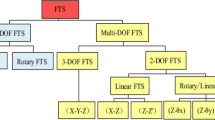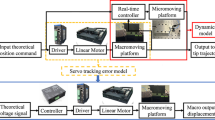Abstract
In this article, a new desktop orthogonal-type robot, which has the capacity of stick-slip motion control based on cutter location data, is presented for lapping small metallic molds with a curved surface. The robot consists of three single-axis devices with a high position resolution of 1 μm. A thin wooden stick tool with a ball-end shape is attached to the tip of the z-axis. In order to improve the lapping performance, a novel stick-slip motion control method is developed in the control system. The small stick-slip motion is orthogonally generated in the direction of the tool’s movement. The effectiveness of stick-slip motion control is examined through an actual lapping test of an LED lens cavity.
Similar content being viewed by others
Explore related subjects
Discover the latest articles, news and stories from top researchers in related subjects.References
Tsai MJ, Chang JL, Haung JF (2003) Development of an automatic mold polishing system. Proceedings of the 2003 IEEE International Conference on Robotics and Automation, Taipei, Taiwan, pp 3517–3522
Tsai MJ, Fang JJ, Chang JL (2004) Robotic path planning for an automatic mold polishing system. Int J Robotics Autom 19(2): 81–89
Bilkay O, Anlagan O (2004) Computer simulation of stick-slip motion in machine tool slideways. Tribol Int 37(4):347–351
Mei X, Tsutsumi M, Tao T, et al (2004) Study on the compensation of error by stick-slip for a high-precision table. Int J Mach Tools Manuf 44(5):503–510
Nagata F, Hase T, Haga Z, et al (2007) CAD/CAM-based position/force controller for a mold polishing robot. Mechatronics 17(4–5): 207–216
Author information
Authors and Affiliations
Corresponding author
Additional information
This work was presented in part at the 15th International Symposium on Artifi cial Life and Robotics, Oita, Japan, February 4–6, 2010
About this article
Cite this article
Nagata, F., Mizobuchi, T., Tani, S. et al. Stick-slip motion control based on cutter location data for an orthogonal-type robot. Artif Life Robotics 15, 106–110 (2010). https://doi.org/10.1007/s10015-010-0775-x
Received:
Accepted:
Published:
Issue Date:
DOI: https://doi.org/10.1007/s10015-010-0775-x




